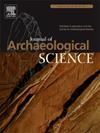揭开在今天塞尔维亚Lepenski Vir的新生儿埋葬背后的故事
IF 2.6
1区 地球科学
Q1 ANTHROPOLOGY
引用次数: 0
摘要
多瑙河峡谷地区的Lepenski Vir是中石器时代和新石器时代的聚落,以艺术砂岩巨石而闻名,这些巨石通常与中石器时代-新石器时代过渡阶段的梯形房屋遗迹有关。此外,新生儿的坟墓被凿进这些建筑物的红灰泥地板上,但原因尚不清楚。我们制作了四个人的古基因组——在梯形房屋的地板下发现了两个新生儿,一个成年人和一个婴儿,他们被埋在一个挨着的坑里。我们的目的是推断它们之间的遗传关系,以了解新生儿的身份,以及为什么他们与房屋一起被埋葬,以及这些独特房屋的功能。遗传结果显示,两个新生儿同时拥有爱琴海/安纳托利亚和铁门狩猎采集者的祖先,并且在建筑物中也存在混合个体。相比之下,在一个坑中发现的个体完全具有爱琴海/安纳托利亚血统。由于没有发现生物学上的联系,因此可以假设这些房屋不具有居住功能。一种可能的解释是,它们是为社区服务的——作为一个生育的地方,或者作为社区社会和仪式活动发生的地方,作为地面上发现的象征性文物和艺术品的支持。研究结果表明,多瑙河峡谷地区存在强大的社会关系,促进了社会文化互动和生物混合,为早期农民和当地采集者提供了利益,并逐渐导致社会和人口变化。本文章由计算机程序翻译,如有差异,请以英文原文为准。
Unveiling the narrative behind the neonate burials at Lepenski Vir in present-day Serbia
Lepenski Vir, in the Danube Gorges area, was a Mesolithic and Neolithic settlement, famous for artistic sandstone boulders often associated with the remains of trapezoidal houses during the Mesolithic-Neolithic Transformation phase. Additionally, neonates' burials were cut into the red-plastered floors of these buildings, but the reasons remained unknown. We produced paleogenomes of four individuals - two neonates found below the floor of the trapezoidal house and one adult and an infant, buried in a pit next to each other. Our aim was to infer genetic relatedness among them to understand the identity of the neonates and why they were buried in association with the houses, as well as what was the function of these unique houses. Genetic results showed that two neonates have both Aegean/Anatolian and Iron Gates hunter-gatherers’ ancestry and that admixed individuals were also present in the buildings. In contrast, individuals found in a pit had entirely Aegean/Anatolian ancestry. Since no biological relatedness was detected, it could be hypothesized that the houses did not function as residential places. One of the possible explanations is that they served the community - as a place for giving birth or as a place where the community's social and ritual activities took place, as supported by symbolic artifacts and artworks found above the floors. The results indicate the existence of strong social relationships in the Danube Gorges, which would facilitate socio-cultural interactions and biological admixtures, providing benefits to early farmers and local foragers, gradually leading to social and demographic changes.
求助全文
通过发布文献求助,成功后即可免费获取论文全文。
去求助
来源期刊

Journal of Archaeological Science
地学-地球科学综合
CiteScore
6.10
自引率
7.10%
发文量
112
审稿时长
49 days
期刊介绍:
The Journal of Archaeological Science is aimed at archaeologists and scientists with particular interests in advancing the development and application of scientific techniques and methodologies to all areas of archaeology. This established monthly journal publishes focus articles, original research papers and major review articles, of wide archaeological significance. The journal provides an international forum for archaeologists and scientists from widely different scientific backgrounds who share a common interest in developing and applying scientific methods to inform major debates through improving the quality and reliability of scientific information derived from archaeological research.
 求助内容:
求助内容: 应助结果提醒方式:
应助结果提醒方式:


